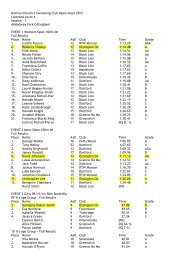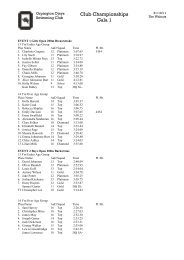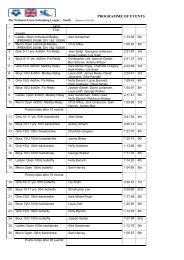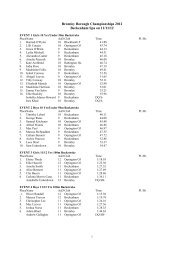EVENT 1: Boys Open - Orpington Ojays Swimming Club
EVENT 1: Boys Open - Orpington Ojays Swimming Club
EVENT 1: Boys Open - Orpington Ojays Swimming Club
Create successful ePaper yourself
Turn your PDF publications into a flip-book with our unique Google optimized e-Paper software.
kHz8—6--4 -a" 0 •tiff.2—1 2 SecFig. 2. The sonagram of the Chick-a-dee call complex of an adult chickadee thataccompanied the young bird banded at Richland Balsam on 9 August 1978 showsmarked similarities to the sonagram (Fig. 4) of the same vocalization given by a birdpositively identified as a Black-capped. (Recording by Michael Tove)kHz8—6—4—2—1 2 SecFig. 3..The sonagram of the Begging Dee calls of the young bird banded andphotographed (Fig. 1) at Richland Balsam shows the slow rate of delivery typical forthe Black-capped Chickadee. (Recording by Michael Tove)primaries and rectrices were still in sheath. The bill was not full-sized, but the legs and feetwere fully developed. The bib was smaller than might be expected, and the buffy flanks werelacking. Otherwise, the fledgling resembled its parents. The bird was banded with analuminum U.S. Fish and Wildlife Service band and a red plastic leg band. Its measurementswere wing cord 47 mm, tail 31 mm, bill from nares 5 mm, and weight 8 g.Bent (1964) noted that Black-capped Chickadees experience a partial postjuvenal moltaround midsummer, but it involves only the contour plumage and wing coverts. This clearlywas not the case with the young chickadee banded on 9 August because that bird was stillacquiring its first flight feathers and not molting contour plumage or secondary coverts.Three factors led to the identification of the preflight bird as a Black-capped Chickadeerather than a Carolina Chickadee (P. carolinensis), which is widespread and common inNorth Carolina and sometimes breeds at high elevations in the mountains (Tanner 1952).First, the bird was found at an elevation above 1900 m, which is considerably higher thanthe usual 1250-1370 m region of contact between Black-capped and Carolina Chickadees inthe southern Appalachians.Second, both parents were seen and their voices recorded. The calls included both the2 The Chat
















